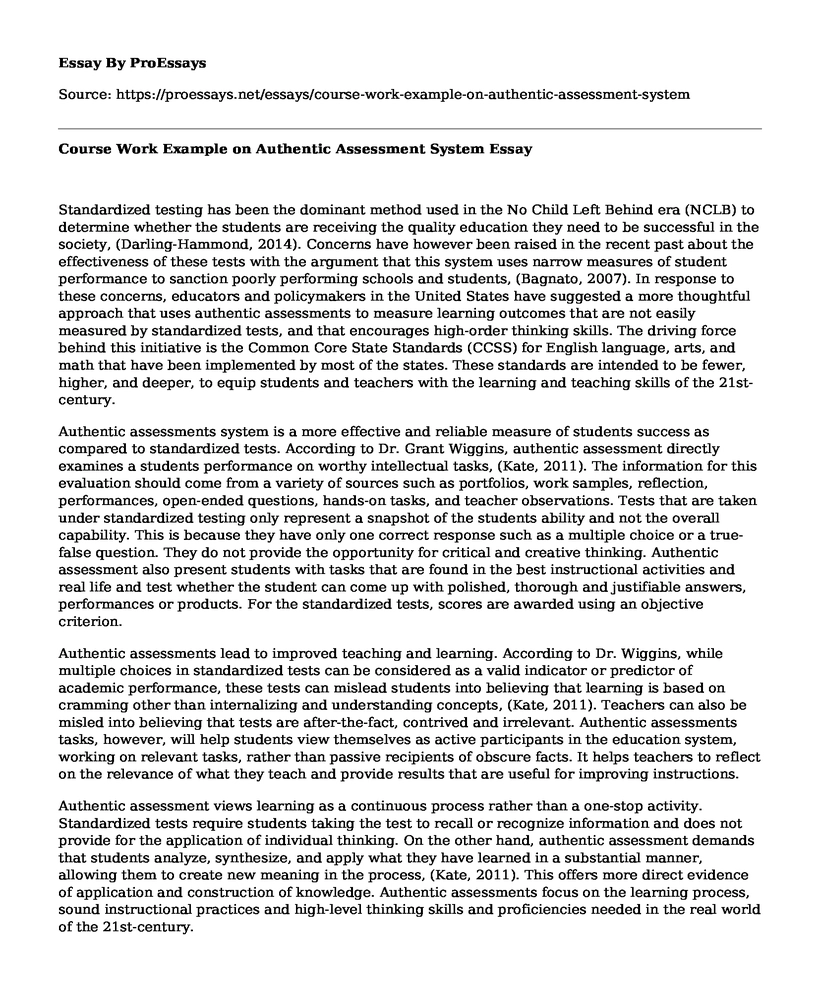Standardized testing has been the dominant method used in the No Child Left Behind era (NCLB) to determine whether the students are receiving the quality education they need to be successful in the society, (Darling-Hammond, 2014). Concerns have however been raised in the recent past about the effectiveness of these tests with the argument that this system uses narrow measures of student performance to sanction poorly performing schools and students, (Bagnato, 2007). In response to these concerns, educators and policymakers in the United States have suggested a more thoughtful approach that uses authentic assessments to measure learning outcomes that are not easily measured by standardized tests, and that encourages high-order thinking skills. The driving force behind this initiative is the Common Core State Standards (CCSS) for English language, arts, and math that have been implemented by most of the states. These standards are intended to be fewer, higher, and deeper, to equip students and teachers with the learning and teaching skills of the 21st-century.
Authentic assessments system is a more effective and reliable measure of students success as compared to standardized tests. According to Dr. Grant Wiggins, authentic assessment directly examines a students performance on worthy intellectual tasks, (Kate, 2011). The information for this evaluation should come from a variety of sources such as portfolios, work samples, reflection, performances, open-ended questions, hands-on tasks, and teacher observations. Tests that are taken under standardized testing only represent a snapshot of the students ability and not the overall capability. This is because they have only one correct response such as a multiple choice or a true-false question. They do not provide the opportunity for critical and creative thinking. Authentic assessment also present students with tasks that are found in the best instructional activities and real life and test whether the student can come up with polished, thorough and justifiable answers, performances or products. For the standardized tests, scores are awarded using an objective criterion.
Authentic assessments lead to improved teaching and learning. According to Dr. Wiggins, while multiple choices in standardized tests can be considered as a valid indicator or predictor of academic performance, these tests can mislead students into believing that learning is based on cramming other than internalizing and understanding concepts, (Kate, 2011). Teachers can also be misled into believing that tests are after-the-fact, contrived and irrelevant. Authentic assessments tasks, however, will help students view themselves as active participants in the education system, working on relevant tasks, rather than passive recipients of obscure facts. It helps teachers to reflect on the relevance of what they teach and provide results that are useful for improving instructions.
Authentic assessment views learning as a continuous process rather than a one-stop activity. Standardized tests require students taking the test to recall or recognize information and does not provide for the application of individual thinking. On the other hand, authentic assessment demands that students analyze, synthesize, and apply what they have learned in a substantial manner, allowing them to create new meaning in the process, (Kate, 2011). This offers more direct evidence of application and construction of knowledge. Authentic assessments focus on the learning process, sound instructional practices and high-level thinking skills and proficiencies needed in the real world of the 21st-century.
In conclusion, authentic assessment proves to be the solution to the learning needs of the 21st-century. The activities involved in this system engage students more intellectually, as well as serve as learning opportunities for teachers. Students exposed to these assessments have huge advantages over those who have not.
References
Bagnato, S. J. (2007). Authentic assessment for early childhood intervention: Best practices. Guilford Press.Darling-Hammond, L. (2014). Testing to, and beyond the Common Core. Principal, 93 (3), 8-12.
Kate D. (2011, August 3). Authentic assessment [Video file]. Retrieved from http://www.youtube.com/watch?v=c_gibuFZXZw
Cite this page
Course Work Example on Authentic Assessment System. (2021, Jul 17). Retrieved from https://proessays.net/essays/course-work-example-on-authentic-assessment-system
If you are the original author of this essay and no longer wish to have it published on the ProEssays website, please click below to request its removal:
- Essay on Child and Adolescent Development
- Graduation Essay From Middle School
- Essay Sample on Developmental Milestones: Birth to Kindergarten
- Positive School Culture - Essay Sample
- Essay Sample on United States Border Patrol
- Essay on Teachers' Impact on Learner Performance: The Reinforcement Theory
- Paper Example on University of Melbourne: Capitalize Opportunities and Create a Value Proposition







